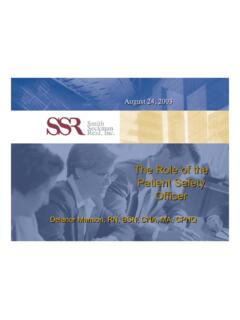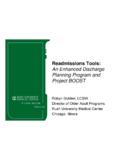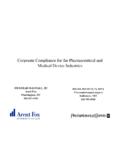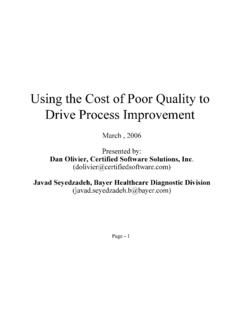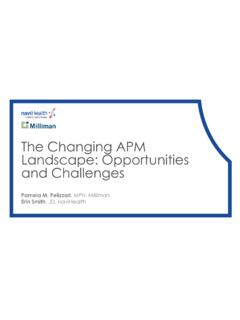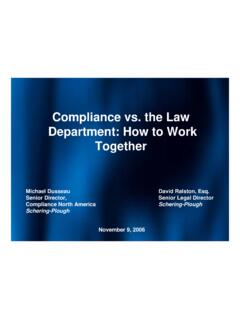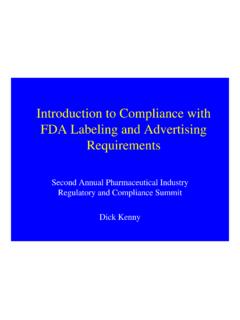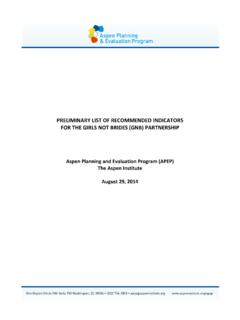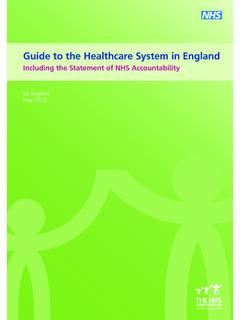Transcription of Whatever Happened to the Fair Information Principles
1 Whatever Happened to the Fair Information Practices ?Beth Givens Director Privacy Rights Clearinghouse Privacy Symposium August 22, 2007 Cambridge, MATopics Definition and origins of FIPs Overview of key codes HEW Principles , 1973 OECD Principles , 1981 Canadian Model code , 1995, & nat l law, 2000 NTIA s Elements of Self-Regulation, 1998 Federal Trade Commission s FIPs, 1998 EU Data Protection Directive, 1998 safe Harbor Agreement, 2000 APEC Privacy Framework, 2005 Global Privacy Standard, 2006 Sector-Specific Codes Accountancy and Health Conclusions & ResourcesAbout the Privacy Rights Clearinghouse Nonprofit organization Established 1992, San Diego, CA Two-part mission: education & advocacy Consumer hotline via e-mail and phone Consumer guides: 50+ Fact Sheets ID theft, credit, online, telemarketing, medical, employment screening, & more Web: Are the Fair Information Practices (FIPs) ? Fair Information practices (FIPs) are a set of Principles for defining and addressing concerns about privacy of personal Information .
2 In most countries with privacy laws, [they are the] core privacy Principles .. incorporated in privacy and data protection laws. -- Robert Gellman s essay on FIPS in Encyclopedia of Privacy (2007)Origins of the Fair Information PracticesAn early expression of FIPs is found in the definition of Information privacy (1967): ..the claim of individuals .. to determine for themselves when, how, and to what extent Information about them is communicated to others. -- Alan Westin, Privacy and Freedom (1967)Origins of FIPs, cont d. Embedded in Fair Credit Reporting Act (FCRA) of 1970 Access to one s own credit report Use limitations -- legitimate business purposes Accuracy and correction Recourse if illegitimately accessed and misusedDevelopment of FIPsReports in early 1970s In Britain, the Younger Committee report 10 Principles (1972) Alan Westin & Michael Baker, Databanks in a Free Society (1973) -- called for formulation of codes for record- keeping practices Health, Education and Welfare (HEW) committee report (1973) -- Records, Computers, and the Rights of Citizens-- Colin Bennett, Regulating Privacy (1992)Development of FIPs, cont d.
3 Data protection laws enacted in 1970s FIPs embedded Concerns over advancement of computer technology and its impact on privacy State of Hesse, Germany (1970) Sweden (first nation, 1973), (1974), Germany (1977), France(1978) Council of Europe Resolutions: 73, 74, 81 OECD Guidelines -- International code established by Organization for Economic Cooperation and Development (1981)-- Colin Bennett, Regulating HEW Principles (1973)[Paraphrased]1. No secret systems of personal Ability for individual to find out what is in the record, and how it is Ability for individual to prevent secondary Ability to correct or amend Data must be secure from Paraphrased from 1973 Health, Education and Welfare report:Advisory Committee on Automated Personal Data SystemsOECD Principles (1981) Guidelines on the Protection of Privacy and Transborder Flows of Personal Data 1. Collection limitation 2. Data quality 3. Purpose specification limitation safeguards6. Openness7.
4 Individual participation8. AccountabilityCriticisms of OECD FIPs Some consider them too weak. Allow too many exceptions. Do not require a privacy agency. Have not kept pace with Information technology. Some industry critics want them reduced to notice, choice, and Summarized from Robert Gellman s essay on FIPs, Encyclopedia of Privacy (2007)Canadian Standards Assoc. Model code for Protection of Personal Information (1995) Accountability Identifying purposes Consent Limiting collection Limiting use, disclosure, retention Accuracy Safeguards Openness Individual access Challenging complianceIncorporated into Canada s nat l law, PIPEDA (2001)Emphasis on Self-Regulation in the TRUSTe web site seal program (1997) Elements of model privacy disclosures Information collection and use Communications from the site Information sharing and disclosure Choice / Opt-out Log files, cookies, clear gifs, third-party advertisers, links to other sites, Access, security, changes in policySelf-Regulation in , cont d.
5 Online Privacy Alliance -- Guidelines for Online Privacy Policies (1998)1. Adoption of Privacy Policy2. Notice and Disclosure3. Choice and Consent4. Data Security5. Data Quality and NTIA s Elements of Self-Regulation (Jan. 1998)Fair Info. Practices1. Awarenessa. Privacy policiesb. Notificationc. Consumer education2. Choice3. Data security4. Consumer accessEnforcement1. Consumer recourse2. Verification3. ConsequencesNat l Telecomm s andInformation Admin. , Dept. of Commerce Federal Trade Commission Fair Information Practice Principles (June 1998)1. Notice / Awareness2. Choice / Consent3. Access / Participation4. Integrity / Security5. Enforcement / Redressa. Self-Regulationb. Private Remediesc. Government EnforcementShortcomings of Self-Regulatory Approach Absence of collection limitation provision Absence of use limitation principle Self-regulatory environment Limited enforcement No privacy agency per seEuropean Union Data Protection Directive (Adopted 1998)Rights of data subjects, including: Right of access to data.
6 Right to know where the data originated. Right to have inaccurate data corrected. Right of recourse in the event of unlawful processing of Data Protection Directive, cont d. (1998)Rights of data subjects, cont d. Right to withhold permission to use their data in certain circumstances. Where data is transferred from EU country to a non-EU country, Article 25: Non-EU country receiving the data must provide an adequate level of data Summarized from Morrison & FoersterLegal Updates, 02/2000 safe Harbor Privacy Principles Dept. of Commerce (Signed July 21, 2000, Implemented July 1, 2001) Notice Choice Onward transfer Security Data integrity Access Enforcement_____For use by entities receiving personal data from the EU in order to qualify for safe harbor and presumption of adequacy. APEC Privacy Framework Asia-Pacific Economic Coop. (2005) Preventing harm Notice Collection limitation Uses of personal Information Choice Integrity of personal Information Security safeguards Access & correction AccountabilityGlobal Privacy Standard (2006) Consent Accountability Purposes Collection limitation Data minimization Use, retention and disclosure limitation Accuracy Security Openness Access ComplianceAdopted at 28th Intnat l.
7 Data Protection Commissioners Conference Nov. 2006 Sector-Specific Codes Privacy Framework, American Institute of Certified Public Accountants & Canadian Institute of Chartered Accountants (2003) renamed Generally Accepted Privacy Principles Connecting for Health s Policy Principles , Markle Foundation (2006) part of Connecting for Health Common FrameworkAccountants code Generally Accepted Privacy Principles Choice and consent Management Notice Collection Use and retention Disclosure to third parties Quality Security Notice Access Monitoring and enforcementAICPA / CICA Principles , 2003 Connecting for Health s Policy Principles -- Markle Foundation Openness and transparency Purpose specification and minimization Collection limitation Use limitation Individual participation & control Data integrity and quality Security safeguards and controls Accountability and oversight RemediesConnecting for Health s Common Framework -- 2006Do the FIPs Matter?
8 Concluding remarks on impact of FIPs: Setting the stage for effective laws and industry policies. The importance of robust standards for meaningful consumer protection. However .. FIPs are one thing implementation and enforcement are quite another. Resources Colin Bennett, Regulating Privacy (1992) Paula Bruening, Elements of Effective Self- Regulation for Protection of Privacy at (1998) Canadian Internet Policy & Public Interest Clinic, Compliance with Canadian Data Protection Laws: Are Retailers Measuring Up? (2006)Cont , cont d. Ann Cavoukian, A Comparison and Gap Analysis of Leading Privacy Codes: An Attempt at Harmonization (2005) Ann Cavoukian, 7 Laws of Identity: The Case for Privacy-Embedded Laws of Identity in the Digital Age (2006) Ann Cavoukian and Don Tapscott, Who Knows: Safeguarding Your Privacy in a Networked World (1997)Cont , cont d. Electronic Privacy Information Center & Privacy International, Transborder Data Flows and Data Havens, , Privacy & Human Rights (2004) David Flaherty, Protecting Privacy in Surveillance Societies (1989) Robert Gellman, Fair Information Practices, in Encyclopedia of Privacy (2007)Cont , cont d.
9 Paul Schwartz & Joel Reidenberg, Data Privacy Law: A Study of United States Data Protection (1996) H. Jeff Smith, Managing Privacy: Information Technology and Corporate America (1994) Robert Ellis Smith, Ben Franklin s Web Site: Privacy and Curiosity from Plymouth Rock to the Internet (2004) Robert Ellis Smith, Law of Privacy in a Nutshell (1993)Cont , cont d. Doreen Starke-Meyerring, European Data Protection Directive, in Encyclopedia of Privacy (2007) Peter Swire, None of Your Business: World Data Flows, Electronic Commerce, and the European Privacy Directive (1998) Dept. of Health, Education and Welfare, Records, Computers and the Rights of Citizens: Report of Secretary s Advisory Committee on Automated Personal Data Systems (1973)Contact InformationBeth Givens, Director Privacy Rights Clearinghouse 3100 - 5th Ave., Suite B San Diego, Ca. 92103 Phone: (619) 298-3396 E-mail bgivens at Web.
